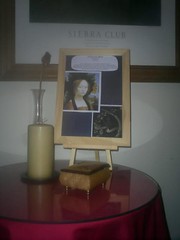Mariel began Age of Fable today and said Mr. Bulfinch used too many big words in the preface, but she was glad to see that he briefly told some myths as well. Age of Fable is a work that shows how poets and authors of literature weave mythology into their work to pack more of a descriptive punch, and I have decided that I will read along with Mariel and help her discern Mr. Bulfinch's purpose. She didn't like this at first, but I told her that she and Triss know more mythology than I have ever learned, and that I am one of the people who "finds Milton 'harsh and crabbed'", and would benefit from adding to my "more solid acquirements the easy learning of this little volume" in order to increase my enjoyment and comprehension of poetry and literature. She felt very sorry to know my ignorance then (I wonder she has never noted it before), and solicitous of my education, sweet girl.
Cornflower's favorite book in Year 1 is James Herriot's Treasury for Children. She cannot get enough of it. She is not so excited about phonics, but is willing to put up with it since it doesn't take too long. I am trying to find some online phonics games, but what I have seen so far either is not engaging or is too basic. Sometimes I wonder if she even needs the phonics. She appears to be a natural speller and can read at around a third grade level already. Hmm.
We have an hour of home economics scheduled each day, and spent our hour today in the garage and attic preparing for a Girl Scout garage sale-- after I retaught How To Clean A Bathroom, which took about twenty minutes. It is really a combination of home ec and charm school, which I think is just right since a charming hostess (or four) is wonderful to have in the home. Here are some of my other home ec plans for the next few weeks:
*Manners when a guest in someone else's home
*Cleaning the entrance, front porch and dining room
*Manners in a crowd of people
*How to brush your teeth
*Cleaning the kitchen
*How to shelve books
*Fixing your hair using a blow dryer and curling iron
*Party Manners
*Conversation Manners
*Proper diet and exercise
*How to organize dresser drawers
*Packing for a trip
*Table Manners
*Cleaning a bedroom
*How to organize a closet
*How a lady stands, sits and walks
This may seem kind of funny, because they ought to be picking these things up by osmosis-- but perhaps that scientific principle does not function properly at our house. Just kidding. ;o) These are lessons that bear repeating, and habits that tend to fall into disrepair when we are not looking.
Yesterday we discussed how to behave in a learning environment. When I was teaching third and fourth graders at a singing school this summer I made the pleasant discovery that if you ask kids to come up with "class rules" they are more apt to cheerfully comply with them. So I applied that in our home, introducing the topic with a discussion of Emily Post's three principles of good manners: Respect, Consideration and Honesty. I liked the girls' list, too. Here is what they came up with:
1. Pay attention to your own work. Don't get distracted.
2. Help when someone is bleeding, bruised or ill.
3. Don't laugh when people make mistakes.
4. Be cheerful.
5. Put your hand on Mommy's arm when you have a question and she is talking with someone else.
6. When Mommy says no, refrain from begging.
7. Keep your hands to yourself (this applies to poking, grabbing, etc. Hugs are okay.)
8. Listen to whoever has the Talking Stick* during group discussions.
9. No bragging.
10. No freaking out!
11. Tell Mom if someone is hurt, in danger or is damaging property. Otherwise, work it out yourself.
(The last two are the kids' favorites from a schoolteacher's list of rules that we have had posted for a week or so. They were called "Mrs. H's Rules," and I cannot find them online now, so if you are the blogger who recommended them would you please post in the comments? I want to give credit where credit is due!)
It's going to take a couple of weeks to figure things out. I'm already making notes where I see that our schedules can fall more in line with the natural rhythm of our home life, and I am watching to see what needs to be altered or removed. I am reasonably certain the school load will prove too heavy, at least for the older two. Next week we add activities. That should be interesting.
* The Talking Stick is a stick around eight inches long, found on a nature walk. We are using it to learn not to interrupt each other. I need the discipline of the Talking Stick as much as anyone else in this house. We all have such scintillating ideas to share, and think we cannot wait because we might forget. We are going to decorate it next week.












